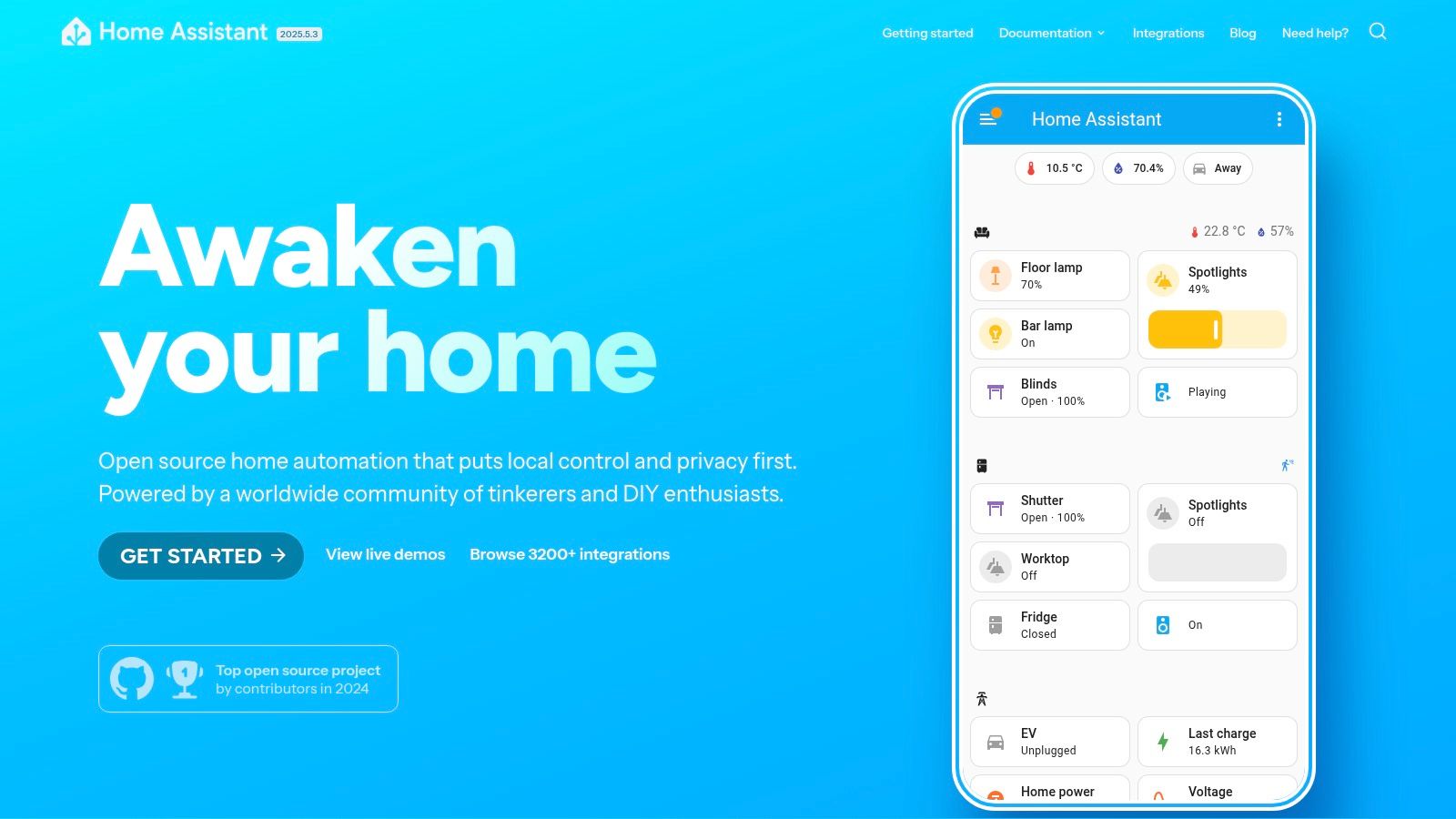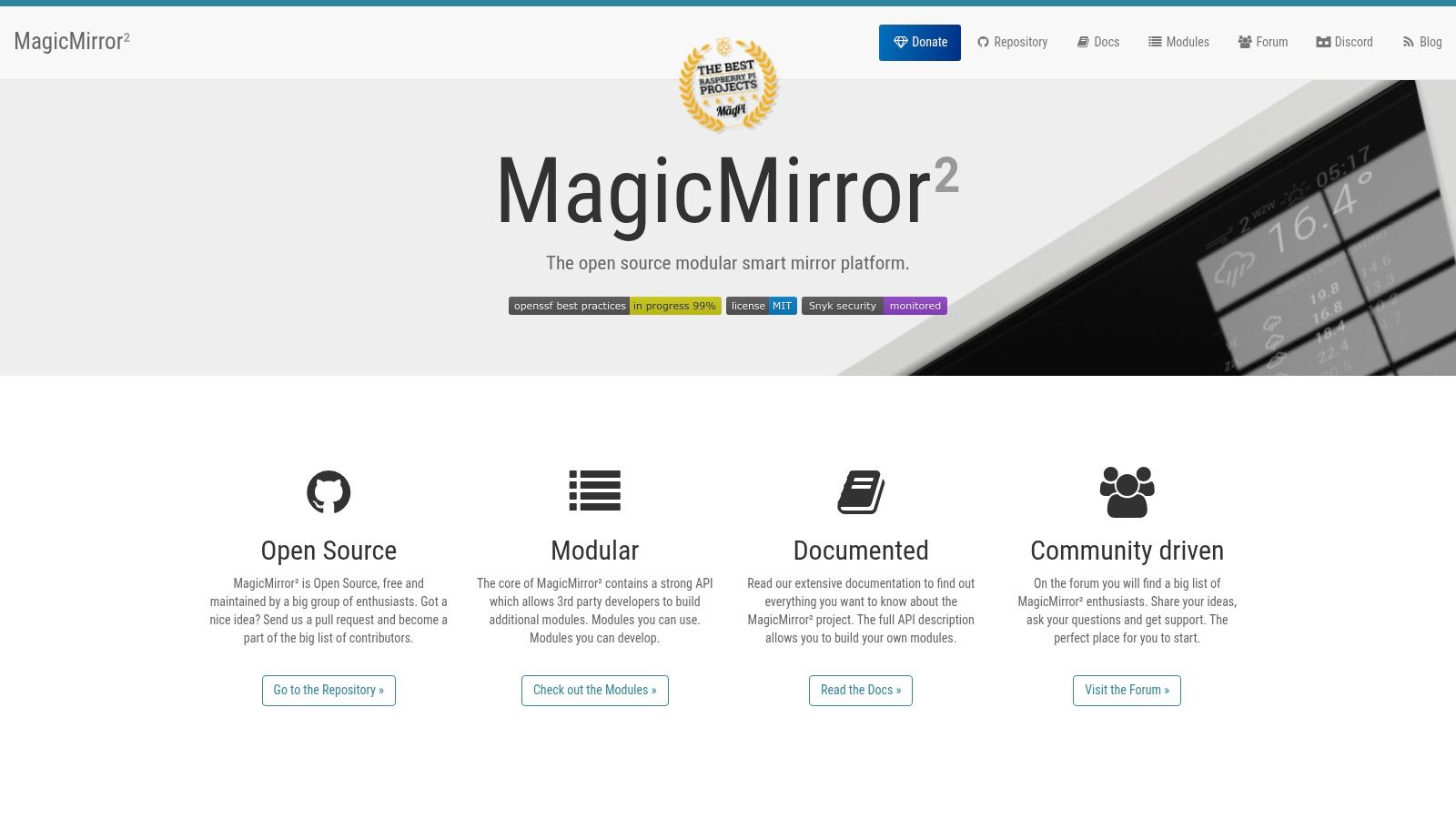
Level Up Your Tech Skills with These Awesome Raspberry Pi Projects
Want exciting Raspberry Pi project ideas? This list delivers 10 diverse projects, from a simple weather station to an AI-powered security system. Whether you're a beginner or a seasoned maker, these projects offer practical applications and creative challenges. Learn to build a smart home hub, a retro gaming console, or even a network storage server. These projects offer affordable solutions for home security, entertainment, and automation. Explore these Raspberry Pi project ideas and start building!
1. Raspberry Pi Home Security Camera System
Transform your Raspberry Pi 4 into a robust and personalized home security system, offering a compelling alternative to expensive commercial solutions. This project allows you to build a comprehensive surveillance setup with multiple camera modules, motion detection, live streaming, and smartphone alerts, all while retaining control over your data and avoiding recurring subscription fees. This makes it a perfect raspberry pi project idea for the tech-savvy and budget-conscious homeowner. Whether you’re a tech enthusiast looking for a challenging project, a family seeking an affordable security solution, or simply someone who values data privacy, this DIY security system offers a compelling blend of functionality and control.

This project is particularly appealing because of its flexibility and customization options. You can tailor the system to your specific needs, whether it's monitoring your front door, keeping an eye on pets, or securing your entire property. Features like night vision support ensure round-the-clock surveillance, while cloud storage integration with services like Google Drive and Dropbox offers convenient offsite backup. A web-based monitoring interface allows you to access your camera feeds from anywhere with an internet connection, providing peace of mind whether you're at home or away. Furthermore, multi-camera support with centralized control lets you manage multiple viewpoints from a single interface, transforming your Raspberry Pi into a powerful surveillance hub.
The cost-effectiveness of this project makes it a standout choice compared to commercial systems that often come with hefty upfront costs and ongoing subscription fees. By utilizing the versatile Raspberry Pi, you're investing in a platform that can be adapted and expanded upon, providing a future-proof security solution. For instance, you can start with a single camera and gradually add more as needed, or integrate other sensors for enhanced security measures. This modular approach allows you to scale your system according to your budget and requirements.
Implementing this project involves a few key components. You'll need a Raspberry Pi 4 (recommended for its processing power), a compatible camera module (or modules for multi-camera setups), a microSD card for storage, and a stable power supply. The Raspberry Pi Foundation website (https://www.raspberrypi.org) provides comprehensive resources and tutorials to guide you through the setup process, including software installation and configuration. While some technical expertise is required, the readily available online resources make it an achievable project even for those new to Raspberry Pi.
While the benefits are numerous, it's important to be aware of the potential drawbacks. Setting up the system requires a certain level of technical proficiency, including familiarity with command-line interfaces and network configurations. A stable internet connection is crucial for remote access and cloud storage functionality. Furthermore, the system's weatherproofing may be limited, requiring additional housing for outdoor cameras. Finally, depending on your recording settings and the number of cameras, the system can consume significant bandwidth.
Compared to commercial systems, this DIY approach offers unparalleled control and customization. You're not locked into proprietary software or hardware, giving you the freedom to choose the components and features that best suit your needs. While commercial systems might offer more polished user interfaces and advanced features, they often lack the flexibility and cost-effectiveness of a Raspberry Pi-based solution. This project empowers you to take control of your home security without compromising on features or breaking the bank, making it a truly valuable raspberry pi project idea.
2. Smart Home Automation Hub
Transform your Raspberry Pi into the ultimate smart home command center with this ambitious yet rewarding project. Building a smart home automation hub allows you to centralize control of your various smart devices, sensors, and appliances, offering a seamless and integrated home automation experience. This project is perfect for tech enthusiasts seeking a powerful, customizable, and cost-effective alternative to commercial smart home hubs. This Raspberry Pi project idea puts you firmly in control of your home automation, offering a level of flexibility and customization simply unavailable with off-the-shelf solutions.

Imagine controlling your lights, thermostat, security cameras, and even your coffee maker from a single interface, all orchestrated by your trusty Raspberry Pi. This project leverages open-source platforms like Home Assistant (https://www.home-assistant.io), which integrates with over 1000 smart devices and platforms, giving you unparalleled control and interoperability. Whether you're using Philips Hue lights, a Nest thermostat, or a Ring doorbell, Home Assistant can likely bring them all together under one roof. This eliminates the need to juggle multiple vendor-specific apps, simplifying your smart home experience drastically.
Beyond simple device control, a Raspberry Pi-powered smart home hub opens up a world of automation possibilities. You can create custom rules and schedules to automate tasks based on time of day, sensor readings, or even your location. Imagine your lights turning on automatically as you arrive home, your thermostat adjusting based on the weather forecast, or your security system activating when you leave. The only limit is your imagination! This level of granular control allows you to fine-tune your home environment for maximum comfort, convenience, and security.
For the budget-conscious, building your own smart home hub with a Raspberry Pi offers significant cost savings compared to commercial hubs. A Raspberry Pi, along with the necessary accessories like a microSD card and power supply, represents a fraction of the cost of a proprietary hub. This makes sophisticated home automation accessible to a wider audience, putting powerful control within reach without breaking the bank.
Furthermore, this setup grants you complete local control, meaning your data stays within your home network and isn't reliant on cloud services. This is a major advantage for privacy-conscious users who prefer not to share their home automation data with third-party companies.
While this raspberry pi project idea offers numerous benefits, it's important to acknowledge the potential challenges. The initial setup can be complex, requiring networking and programming knowledge. You'll need to be comfortable working with the command line and configuring software. Additionally, potential compatibility issues can arise with some devices, requiring troubleshooting and research. Finally, configuring and maintaining your smart home hub can be time-intensive, requiring ongoing attention and updates.
Here are a few implementation tips to get you started:
- Start small: Begin with a few key devices and gradually expand your system as you gain experience.
- Follow online tutorials: Numerous resources are available online, including step-by-step guides and community forums.
- Back up your configuration regularly: This will save you time and frustration in case of any issues.
This project is an excellent choice for those seeking a challenging yet rewarding raspberry pi project idea. The ability to create a customized, powerful, and cost-effective smart home hub is a compelling proposition for tech enthusiasts, budget-conscious shoppers, and anyone looking to take control of their home automation. While it requires a significant time investment and technical know-how, the benefits of a truly personalized smart home experience make this project well worth the effort.
3. Retro Gaming Console (RetroPie)
Transform your Raspberry Pi into the ultimate retro gaming powerhouse with RetroPie. This incredible software emulates over 50 vintage gaming systems, bringing thousands of classic games back to life. From the 8-bit nostalgia of the NES and Master System to the 16-bit adventures of the SNES and Sega Genesis, all the way to the polygon-pushing PlayStation and arcade classics, RetroPie offers a vast library of gaming history at your fingertips. This project is perfect for budget-conscious gamers, tech enthusiasts seeking a fun project, and families looking for affordable entertainment options. It also caters to the portable needs of travel and outdoor adventurers. RetroPie turns a small, inexpensive computer into a versatile entertainment center, making it a compelling addition to any Raspberry Pi project ideas list.

One of RetroPie’s most appealing features is its broad compatibility. It supports a wide range of wireless and USB controllers, allowing you to use everything from classic-style gamepads to modern Bluetooth controllers. This flexibility gives you a truly authentic retro gaming experience tailored to your preference. Furthermore, the software includes features like save states and game progress backups, ensuring you never lose your hard-earned progress. Customizable themes and user interfaces allow you to personalize your retro gaming experience, while Kodi media center integration expands the functionality beyond just games, transforming your Raspberry Pi into a complete entertainment hub.
RetroPie offers an undeniably affordable way to relive classic gaming memories. Compared to purchasing original consoles, which can be expensive and difficult to find in good condition, a Raspberry Pi and RetroPie setup provides a significantly cheaper alternative. The compact and portable design of the Raspberry Pi also makes it easy to take your retro gaming collection anywhere, appealing to travel and outdoor adventurers. This portability factor is a significant advantage over bulky original consoles or modern gaming setups.
Getting started with RetroPie requires some technical knowledge. You’ll need a Raspberry Pi (any model will work, but a Raspberry Pi 3 or 4 is recommended for optimal performance), a microSD card, a power supply, and a USB or wireless controller. The setup involves downloading the RetroPie image, flashing it onto the microSD card, and configuring the system. While the process is well-documented on the RetroPie website and within a supportive online community, it's not entirely plug-and-play. Keep in mind that controllers are sold separately, adding to the overall cost.
A key consideration with RetroPie, and any emulation project, is the legal aspect of ROM acquisition. Downloading ROMs for games you don't own is illegal in many countries. Ensure you only use ROMs for games you already own, and understand the legal implications within your region. Learn more about Retro Gaming Console (RetroPie) The link discusses challenges in the retro gaming market, highlighting the increasing cost and complexity of acquiring original hardware, further strengthening the case for RetroPie as a cost-effective and convenient alternative.
While RetroPie offers an impressive range of compatibility, some games, particularly demanding PlayStation or N64 titles, may encounter performance issues depending on your Raspberry Pi model. Thorough research on game compatibility with your specific Raspberry Pi model is recommended before investing time in setup. Despite these potential hurdles, the vast library of games, affordability, portability, and active community support make RetroPie a standout choice for any Raspberry Pi enthusiast. For a relatively low cost, you gain access to thousands of classic games, transforming your Raspberry Pi into a versatile and nostalgic entertainment system. Visit the official RetroPie website (https://retropie.org.uk) for detailed setup instructions, community forums, and the latest updates.
4. Weather Station Monitor
Transform your Raspberry Pi into a sophisticated weather station capable of rivaling commercial setups! This project provides a fantastic opportunity to delve into meteorology, electronics, and programming while building a practical tool that delivers highly accurate, localized weather information. This "Raspberry Pi project idea" combines educational value with tangible benefits, making it a perfect choice for tech enthusiasts, educators, and anyone interested in gaining a deeper understanding of the weather around them.

This comprehensive environmental monitoring system goes beyond basic temperature readings. It allows you to measure a range of crucial weather parameters including humidity, barometric pressure, wind speed, and even rainfall. Imagine having access to precise, real-time data directly from your backyard, empowering you to make informed decisions about your day, gardening activities, or even upcoming travel plans. This "raspberry pi project idea" truly shines in its versatility and potential applications.
The data collected by your DIY weather station is not just displayed instantaneously. The system logs this information, allowing you to perform historical analysis, identify trends, and even correlate weather patterns with other events. This historical data is accessible through a web-based dashboard, viewable on any device thanks to its mobile responsiveness. Imagine checking your local weather data from your phone while on the go, or analyzing past rainfall trends from the comfort of your couch.
This "raspberry pi project idea" elevates its capabilities further by integrating with online weather services. This not only provides a point of comparison for your own collected data but also enables more accurate local forecasting, potentially surpassing the generalized predictions available from national weather sources. Think of it as having your own personalized weather forecasting service, tailored to your specific location.
Building a Raspberry Pi weather station provides numerous advantages over purchasing a commercial weather station. First and foremost, it is significantly more cost-effective, especially if you already own a Raspberry Pi. This makes it a great choice for budget-conscious individuals and families. Furthermore, this project offers a valuable learning experience, teaching you about electronics, coding, and meteorology. The customizable nature of the project allows you to tailor the station to your specific needs, choosing the sensors and features most relevant to you. You can even set up customized alerts and notifications, for example, receiving an alert if the wind speed exceeds a certain threshold.
However, like any DIY project, building a Raspberry Pi weather station comes with its challenges. Protecting the outdoor sensors from the elements with a weatherproof housing is crucial for longevity and accurate readings. Sensor calibration is necessary to ensure the data collected is reliable, and wiring multiple sensors can be complex, requiring careful planning and execution. Finally, ongoing maintenance may be required, especially in harsh weather conditions.
Getting Started:
The foundation of this project lies with the Raspberry Pi (any model will generally suffice), coupled with various sensors. You’ll need temperature, humidity, barometric pressure, wind speed, and rainfall sensors. A weatherproof enclosure for the outdoor components is a must. Software-wise, you'll be using a programming language like Python, and a database for data logging. Numerous online tutorials and resources (check out the official Raspberry Pi website at https://www.raspberrypi.org) provide step-by-step guidance. The cost can range from $50 to $150 depending on the sensors chosen and whether you already own a Raspberry Pi.
By taking on this "raspberry pi project idea", you'll not only gain a powerful and personalized weather station, but also a deep understanding of how such systems work. It’s a project that merges practicality, education, and a bit of DIY ingenuity, making it a rewarding endeavor for a wide range of individuals, from tech-savvy hobbyists to families looking for an engaging and educational project.
5. Magic Mirror Display
Transform your ordinary mirror into a futuristic information hub with a Raspberry Pi-powered Magic Mirror. This project elevates the simple act of checking your reflection into an interactive experience, providing personalized information at a glance. Imagine seeing the weather forecast, your daily schedule, news headlines, and even traffic updates while you get ready in the morning, all displayed seamlessly on your mirror’s surface. This project is a perfect blend of practicality and "wow" factor, making it an excellent choice for a Raspberry Pi project. It's especially appealing to tech enthusiasts who appreciate DIY projects and the customization a Raspberry Pi allows, as well as anyone looking for a unique and functional smart home upgrade.

The Magic Mirror is built using a two-way mirror, a display monitor, and a Raspberry Pi running the MagicMirror² software. The magic lies in the two-way mirror, which allows a portion of the light from the display behind it to pass through, creating the illusion of the information floating on the mirror's surface. The MagicMirror² software is open-source and highly customizable, thanks to its modular design. With over 200 available modules, you can tailor the displayed information to your specific needs. This makes it an incredibly versatile raspberry pi project idea, appealing to a broad range of users.
One of the most compelling features of the Magic Mirror is its modular widget system. This system allows you to add, remove, and configure various information displays, or "modules," with ease. Want to see your upcoming calendar appointments? There's a module for that. Interested in real-time traffic updates for your commute? There's a module for that too. From displaying news headlines to controlling your smart home devices, the possibilities are vast. This extensibility makes the Magic Mirror a continuously evolving project, unlike static commercial smart displays.
For the budget-conscious, this project presents an opportunity to create a high-tech smart mirror for a fraction of the cost of commercial alternatives. While pricing can vary depending on the size of the mirror and the quality of components, a basic setup can be achieved for a reasonable price, especially if you repurpose an old monitor. Technically inclined users will appreciate the flexibility of the Raspberry Pi platform and the active development community surrounding MagicMirror², which provides extensive documentation and support.
Implementing your own Magic Mirror does require some effort. Building the frame and mounting the components necessitates some basic woodworking or fabrication skills. Sourcing a high-quality two-way mirror can also be a challenge and can contribute significantly to the overall cost. While the software is highly customizable, adding advanced features like voice control or facial recognition requires additional configuration and potentially additional hardware. Furthermore, an always-on display necessitates considering the power consumption and potential heat generation.
Compared to other smart display solutions like Google Nest Hub or Amazon Echo Show, the Magic Mirror offers a more integrated and aesthetically pleasing experience. While those devices provide similar information, they often feel like separate gadgets. The Magic Mirror, on the other hand, seamlessly blends technology into your existing environment. The level of customization also far surpasses what’s available on commercial devices, offering a truly personalized experience.
For those interested in taking on this project, several resources are available. The official MagicMirror² website (https://magicmirror.builders) is an excellent starting point, providing detailed documentation, community forums, and a comprehensive module library. Numerous online tutorials and videos also offer step-by-step instructions, catering to different skill levels. When planning your project, consider the size of your mirror, the placement in your home, and the specific information you want to display to tailor the build to your individual needs. This project, while challenging, offers a rewarding outcome, transforming your daily routine with a touch of futuristic flair, making it a worthy addition to any list of raspberry pi project ideas.
6. Network Attached Storage (NAS) Server
Transform your Raspberry Pi into a personalized cloud storage hub with this practical and cost-effective project. A Network Attached Storage (NAS) server provides a centralized location for storing and accessing your files, backing up important data, and even streaming your media library. This makes it an excellent raspberry pi project idea for anyone looking to take control of their digital assets without breaking the bank. This project caters to a variety of users, from budget-conscious shoppers looking for affordable storage solutions, to tech enthusiasts seeking a challenging and rewarding project, and even families who need a centralized system for sharing photos and videos.

Imagine accessing your files from anywhere in the world, streaming movies to your smart TV without relying on external services, and having the peace of mind knowing your data is securely backed up. This is all achievable with a Raspberry Pi-based NAS. Utilizing software like OpenMediaVault or TrueNAS CORE, you can configure your Raspberry Pi with multiple external USB or SATA drives, implement RAID configurations for data redundancy, and set up user access controls and permissions. This level of control is rarely found in commercial NAS solutions, especially at a comparable price point.
The versatility of this Raspberry Pi project extends beyond simple file storage. With applications like Plex or Emby, your NAS server becomes a powerful media server capable of transcoding media on the fly for seamless playback on various devices. Schedule automated backups to ensure your data is safe and secure, further enhancing the practicality of this setup. For travel and outdoor adventurers, a portable Raspberry Pi NAS solution can provide a central hub for storing and accessing photos and videos captured on the go.
While commercial NAS solutions offer a more plug-and-play experience, the Raspberry Pi NAS provides unparalleled customization and control. A Raspberry Pi 4 is recommended for this project due to its improved processing power and Gigabit Ethernet port, though older models can also be utilized for less demanding workloads. You'll need a microSD card for the operating system, external hard drives (USB or SATA), and potentially a powered USB hub depending on the number of drives. Pricing can vary based on storage capacity and chosen hardware, but it typically remains significantly more affordable than pre-built NAS solutions. For instance, a Raspberry Pi 4 and a couple of 4TB external hard drives can be purchased for under $200, offering a substantial amount of storage for a fraction of the cost of comparable commercial NAS devices.
Setting up a Raspberry Pi NAS can be more technically involved than simply plugging in a commercial NAS. Configuring RAID, setting up remote access via VPN or cloud services, and optimizing the media server for transcoding requires some technical know-how. The Raspberry Pi's processing power, particularly for transcoding, can be a limiting factor compared to higher-end NAS devices. Additionally, USB 3.0 bandwidth limitations can impact transfer speeds, especially with multiple drives connected. Implementing a RAID configuration can further complicate the setup process, requiring careful planning and execution.
However, the wealth of online resources, including tutorials and forums dedicated to Raspberry Pi NAS projects, makes the process manageable even for less experienced users. The flexibility and control over your data, combined with the significant cost savings, make this project a compelling alternative to commercial NAS solutions. This raspberry pi project idea provides a unique blend of functionality and affordability, cementing its place as a worthwhile endeavor for anyone seeking a personalized and powerful storage solution. More information and resources on Raspberry Pi projects can be found at https://www.raspberrypi.org.
7. IoT Plant Watering System
This Raspberry Pi project takes plant care to the next level, transforming your traditional garden into a smart, automated ecosystem. Ideal for busy individuals, frequent travelers, or anyone looking to optimize their gardening efforts, this IoT Plant Watering System offers a compelling blend of technology and practicality. This project earns its place on our list of Raspberry Pi project ideas because it showcases the power of the Pi in a tangible, everyday application. By automating a common chore and incorporating data-driven insights, it demonstrates how even beginner programmers can leverage the Raspberry Pi to create something truly useful.

Imagine leaving for a two-week vacation without worrying about your plants withering. This system makes that a reality. By using moisture sensors embedded in the soil, the Raspberry Pi constantly monitors the hydration levels of your plants. When the moisture level drops below a pre-defined threshold, the system automatically activates a pump, delivering the precise amount of water needed. This eliminates the guesswork of traditional watering and ensures your plants receive optimal hydration, preventing both underwatering and overwatering.
The "smart" aspect of this system goes beyond automated watering. By incorporating a weather API, the system can adjust its watering schedule based on real-time weather conditions. If rain is forecast, the system will hold back on watering, preventing waterlogging and conserving this precious resource. This feature makes the system particularly attractive to environmentally conscious gardeners. Furthermore, you can implement multi-zone irrigation control, allowing you to customize watering schedules for different plant types or areas of your garden with varying sunlight and moisture requirements. Some advanced implementations even incorporate camera time-lapse functionality to track plant growth over time, providing fascinating visual documentation of your garden's progress.
This Raspberry Pi project idea offers several compelling benefits. First, it significantly reduces the risk of plant death due to neglect, making it ideal for those with busy schedules or a tendency to forget watering duties. Second, it promotes water conservation through precise monitoring and weather integration. This not only benefits the environment but can also lead to lower water bills. Third, the system is highly scalable. While it can start with a small setup, you can easily expand it to accommodate a larger garden by adding more sensors, pumps, and zones as needed. Finally, the mobile app integration allows you to receive notifications about your garden's status and even manually override the automatic system if needed.
While this project offers many advantages, it’s essential to be aware of potential challenges. Protecting the Raspberry Pi and its associated electronics from the elements is crucial. Weatherproof enclosures are a must, and careful planning is needed to ensure the system remains functional in varying weather conditions. Setting up the pump and plumbing can be complex, particularly for those with limited DIY experience. The accuracy of the soil moisture sensors can also be affected by soil conditions and may require calibration. Finally, like any automated system involving water, there’s a risk of potential water damage if a malfunction occurs, highlighting the importance of regular maintenance and careful setup.
Although pricing will vary depending on the specific components chosen, the core elements of this project (Raspberry Pi, moisture sensors, pump, tubing) can be acquired for a relatively reasonable cost, making it an accessible project for budget-conscious enthusiasts. Technically, this project requires some basic programming knowledge, primarily in Python, and familiarity with connecting and controlling hardware components using the Raspberry Pi's GPIO pins. Numerous online tutorials and resources are available to guide you through the setup process. This project can be a great introduction to the world of IoT and provides a rewarding experience for those interested in combining technology and gardening. More information and potential project guides can be found on the Raspberry Pi Foundation website (https://www.raspberrypi.org). This raspberry pi project idea is sure to be a hit with tech enthusiasts looking for a practical application for their skills.
8. AI Security System with Facial Recognition
Transform your Raspberry Pi into a sophisticated security system that goes beyond basic motion detection with this exciting project. This AI-powered system utilizes computer vision and machine learning to identify known faces, detect intruders, and monitor for suspicious activities, offering a modern and effective approach to home or small office security. This project is a perfect example of how a Raspberry Pi can be used for advanced applications, making it a worthy addition to our list of Raspberry Pi project ideas.

Imagine a security system that not only alerts you to movement but also tells you who is at your door. This project makes that a reality. By training a machine learning model with images of authorized individuals, the system can recognize family members, friends, or employees, granting them access and eliminating the need for physical keys. Conversely, unrecognized faces trigger an immediate alert, notifying you of a potential intruder. This targeted approach minimizes false alarms triggered by pets, wildlife, or swaying trees, common issues with simpler motion-detection systems.
The system goes beyond just identification. It logs visitor access, creating a detailed history of who entered and when. This feature is incredibly useful for businesses, allowing them to track employee attendance or monitor access to restricted areas. Furthermore, the system can integrate with smart home devices, such as smart locks and lighting. Upon recognizing an authorized individual, it can automatically unlock the door and turn on the lights, providing a seamless and convenient experience. The possibilities for automation and integration make this project particularly appealing for tech enthusiasts.
Advancements in AI and the development of more efficient hardware, like the low-power AI inference chip discussed in this article: Learn more about AI Security System with Facial Recognition, are continually pushing the boundaries of what’s possible with embedded AI systems like this. These developments promise even faster and more accurate real-time analysis for future iterations of this project.
While the official Raspberry Pi website (https://www.raspberrypi.org) provides a wealth of resources for various projects, specific pricing details for this particular build depend heavily on the components chosen. A Raspberry Pi board itself is relatively inexpensive, but the camera, any necessary sensors, and potentially a case will add to the overall cost. Budget-conscious shoppers should research different camera modules and other components to find the most cost-effective options.
Implementing this project does require a degree of technical expertise. You'll need to be comfortable working with the Linux command line, setting up the necessary software libraries, and potentially writing some Python code. The process of training the machine learning model also requires careful attention to ensure accuracy. Here are a few implementation tips:
- Gather a diverse dataset: Use a variety of images for each recognized individual, including different angles and lighting conditions, to improve accuracy.
- Consider lighting conditions: Implement consistent lighting in the area being monitored to reduce the impact of varying light levels on the facial recognition accuracy.
- Start small: Begin with a limited set of recognized faces and gradually expand the database as you become more comfortable with the system.
Despite the complexities, the potential rewards of a personalized, AI-powered security system are substantial. However, it's crucial to acknowledge the potential downsides. Privacy concerns surrounding facial recognition technology are valid and should be considered carefully. The system requires significant processing power, which can strain the Raspberry Pi, especially when processing high-resolution video feeds. The setup and training process can also be time-consuming and challenging for beginners. Finally, lighting conditions significantly impact the accuracy of facial recognition, making it essential to consider the environment where the system will be deployed.
This AI Security System project offers a compelling blend of practicality and advanced technology, making it an excellent choice for tech enthusiasts and anyone looking to upgrade their home security with a Raspberry Pi project. It demonstrates the power and versatility of the platform while providing a real-world solution to a common problem.
9. Digital Photo Frame with Cloud Sync
Transform your Raspberry Pi into a dynamic and connected digital photo frame that effortlessly showcases your cherished memories. This project offers a modern alternative to traditional photo frames, automatically syncing with your favorite cloud services, social media feeds, and shared family albums. It's a fantastic Raspberry Pi project idea for anyone looking to combine technology with a touch of personal flair. This connected frame breathes new life into your digital photos, offering a constantly updating view into your most precious moments.

This project is perfect for families spread across the globe, allowing easy photo sharing and keeping everyone connected. Imagine grandparents instantly seeing pictures of their newest grandchild, or friends on a trip sharing their adventures in real-time. This digital photo frame bridges the distance, making sharing life's moments effortless and immediate. Furthermore, the project's customizability opens doors for tech enthusiasts to tailor the frame's functionality and appearance.
Beyond simply displaying photos, this smart frame boasts a wealth of features. Customizable slideshows let you control the pace and order of your photos, while weather overlays provide a quick glance at the local forecast. Calendar integration keeps important dates top-of-mind, and remote management via a smartphone app gives you control over the display from anywhere. This level of control and customization makes the project a versatile tool for both displaying photos and providing useful information.
This project is a particularly strong Raspberry Pi project idea for several reasons. Firstly, its practicality addresses a common need: displaying photos in a modern and engaging way. Secondly, it leverages the Raspberry Pi's capabilities for connectivity and customization, creating a truly personalized experience. Finally, it’s a relatively affordable project, utilizing existing cloud services and requiring minimal hardware beyond the Raspberry Pi itself. While exact pricing depends on the chosen display and any additional accessories, the core components remain budget-friendly.
To get started, you’ll need a Raspberry Pi (a Raspberry Pi 4 Model B is recommended for optimal performance), a power supply, an SD card, and a compatible display. Many HDMI displays work well, and some projects even incorporate touchscreens for added interactivity. Software-wise, you'll need a Raspberry Pi OS installation and then install software to facilitate the cloud syncing and photo display, such as applications leveraging Python libraries or dedicated digital photo frame software. Several community-developed projects offer step-by-step instructions and readily available code, making the setup process relatively straightforward even for beginners.
While commercial digital photo frames exist, this DIY project offers distinct advantages. You gain complete control over the software and features, allowing for deep customization and integration with your preferred services. Furthermore, building the frame yourself provides valuable learning experience and the satisfaction of creating something unique.
However, there are some considerations. This project requires a constant internet connection for cloud syncing. Screen burn-in can be a concern with prolonged use of static images, although this can be mitigated by using varied slideshows and screen savers. The project's functionality is also limited by the APIs of your chosen cloud services. Finally, power consumption will be higher than traditional photo frames, although still relatively low compared to other electronic devices.
Features:
- Cloud service integration (Google Photos, iCloud, Dropbox)
- Automatic photo rotation and slideshow
- Weather and calendar overlay display
- Remote management via smartphone app
- Multiple frame size and orientation support
Pros:
- Always displays current family photos
- Easy sharing among family members
- Replaces traditional photo printing
- Customizable display options
Cons:
- Requires constant internet connection
- Screen may suffer from burn-in over time
- Limited by cloud service API restrictions
- Power consumption higher than traditional frames
For more information and resources, visit https://www.raspberrypi.org. This digital photo frame project is a testament to the versatility of the Raspberry Pi, offering a fun and practical way to display your cherished memories while providing a rewarding tech experience. This Raspberry Pi project idea truly blends functionality, personalization, and technological exploration.
10. Drone/RC Vehicle Controller
Take your Raspberry Pi projects to the skies with this exciting and challenging endeavor: building a custom drone or RC vehicle controller. This project offers a deep dive into robotics, programming, and electronics, allowing you to create a personalized system far more capable and significantly cheaper than off-the-shelf alternatives. Imagine programming autonomous flight paths, capturing stunning aerial footage, and monitoring real-time telemetry data – all powered by the humble Raspberry Pi. This project idea truly showcases the versatility and power packed into this small computer, making it a worthy addition to our list of Raspberry Pi project ideas.

This project allows for customization far beyond what commercially available drone systems offer. You can tailor the controller to your specific needs, whether it's for aerial photography, package delivery, environmental monitoring, or simply recreational flying. By leveraging the Raspberry Pi's processing power, you can implement advanced features like GPS navigation with waypoint missions, real-time telemetry and data logging, First Person View (FPV) video transmission and recording, and autonomous flight modes such as altitude hold and return-to-home functionality. This level of control opens up a world of possibilities for both hobbyists and professionals alike.
Practical applications for a custom drone/RC vehicle controller are numerous. For travel and outdoor adventurers, this project offers a unique way to capture stunning aerial footage of their explorations. Tech enthusiasts and makers can push the boundaries of their skills, creating a truly unique and personalized system. Families can even engage in a collaborative project, learning valuable STEM skills in the process. Budget-conscious shoppers will appreciate the significant cost savings compared to pre-built systems, especially when considering the advanced capabilities achievable with a Raspberry Pi-based solution.
While the potential rewards are significant, it's important to acknowledge the technical challenges involved. This project requires a good understanding of programming, electronics, and robotics. You'll be working with components like GPS modules, IMUs, ESCs, and potentially even soldering and circuit design. Configuring the software, including the flight controller software and ground station interface, will also require some coding proficiency. Furthermore, safety is paramount. Improperly configured drones pose a real risk, and you should always prioritize safe practices and adhere to local regulations regarding drone operation. The calibration and tuning process can also be complex, requiring patience and methodical testing.
While the Raspberry Pi Foundation (https://www.raspberrypi.org) provides a wealth of resources for getting started with various projects, you'll likely need to consult additional online tutorials and communities specifically dedicated to drone building and Raspberry Pi-based flight controllers. Many open-source projects and libraries can significantly simplify the development process.
Pricing for this project is highly variable depending on the chosen components and desired features. The Raspberry Pi itself is relatively inexpensive, but adding peripherals like GPS modules, high-quality cameras, and powerful motors can add to the cost. However, compared to purchasing a similarly equipped commercial drone, the overall cost is typically much lower.
This project offers a rewarding experience for those willing to invest the time and effort. The ability to build a fully customized drone or RC vehicle from the ground up, tailored to your specific needs and preferences, is a compelling prospect. While challenging, the learning process is invaluable, providing practical experience in programming, electronics, and robotics. This project is not for the faint of heart, but the payoff is a powerful and personalized system that showcases the incredible potential of the Raspberry Pi, solidifying its place among the top Raspberry Pi project ideas.
Top 10 Raspberry Pi Project Comparison
| Product | Core Features ✨ | User Experience ★★★☆☆ | Value Proposition 💰 | Target Audience 👥 | Unique Selling Points 🏆 |
|---|---|---|---|---|---|
| Raspberry Pi Home Security Camera | Motion detection, 1080p HD, night vision, cloud storage | Customizable, no subscription, requires tech | Cost-effective, no fees | DIY tech enthusiasts | Full data control, multi-camera support |
| Smart Home Automation Hub | 1000+ device integration, voice control, energy analytics | Extensive customization, complex setup | Saves cost vs commercial hubs | Smart home users, hobbyists | Local control, multi-platform integration |
| Retro Gaming Console (RetroPie) | 50+ emulated systems, controller support, save states | Portable, active community support | Cheaper than originals | Retro gamers, hobbyists | Extensive game library, media center feature |
| Weather Station Monitor | Multi-sensor monitoring, real-time data, forecasting | Highly accurate, educational | Cost-effective vs commercial | Weather enthusiasts, educators | Localized weather predictions |
| Magic Mirror Display | Modular widgets (200+), voice control, facial recognition | Visually striking, highly customizable | Unique home info hub | Tech-savvy, smart home fans | Personalized display, modular design |
| Network Attached Storage (NAS) | RAID support, remote access, media server, backups | Cost-effective, low power, setup complex | Personal cloud, expandable storage | Data hoarders, media streamers | Full data control, Plex integration |
| IoT Plant Watering System | Soil moisture sensors, multi-zone, weather API integration | Prevents neglect, water-saving | Ideal for busy or travel-prone gardeners | Gardeners, busy households | Automated, multi-zone irrigation |
| AI Security System with Facial Rec | Facial recognition, intruder alerts, smart lock integration | Advanced security, privacy trade-offs | High-tech security | Security-conscious homes | ML-powered accuracy, false alarm reduction |
| Digital Photo Frame with Cloud Sync | Cloud syncing, slideshow customization, remote management | Easy sharing, customizable display | Replaces prints, always up-to-date | Families, photo lovers | Family sharing, weather/calendar overlays |
| Drone/RC Vehicle Controller | GPS navigation, telemetry, FPV, autonomous flight modes | Highly customizable, educational | Cheaper than commercial flight controllers | RC enthusiasts, educators | Custom programming, autonomous features |
Ready to Start Building?
From home security systems and smart mirrors to retro gaming consoles and AI-powered projects, these 10 Raspberry Pi project ideas offer a glimpse into the incredible versatility of this tiny computer. Whether you’re a budget-conscious tech enthusiast, a family looking for fun projects, or an outdoor adventurer wanting to build a drone controller, there's a Raspberry Pi project perfect for you. The key takeaway is that the Raspberry Pi's affordability and adaptability make it an ideal platform for bringing your innovative ideas to life. When choosing your project, consider your interests, skill level, and the necessary tools and components. Remember to research the specific requirements for each project, including software, hardware, and any potential safety precautions.
These projects are merely a starting point. The world of Raspberry Pi project ideas is vast and constantly expanding. From simple beginner projects to complex, multi-faceted builds, there’s something for everyone. Choosing the right project depends on your individual goals and technical capabilities. For example, setting up a NAS server requires a different skillset than building a smart watering system.
So, are you ready to unleash your inner maker? Find the perfect tools and trending deals to get started on your Raspberry Pi journey with FindTopTrends. We offer a curated selection of products and resources to help you explore the world of Raspberry Pi project ideas and make your next creation a reality. FindTopTrends










